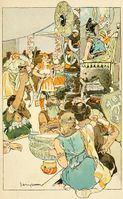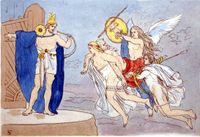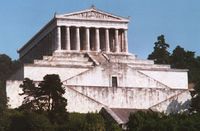ڤالهالا

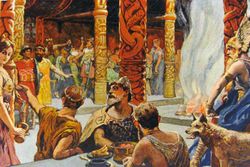
في الأساطير النوردية، ڤالهالا (Valhalla ؛ /vælˈhælə,_vɑːlˈhɑːlə/؛[1] من النورسية القديمة ڤالهول Valhöll "قاعة القتلى")[2] هي قاعة مهيبة ضخمة تقع في آسگارد، يحكمها الإله أودين. كان أودين يختار نصف من قضوا نحبهم في القتال، فيسافروا إلى ڤالهالا بمجرد موتهم، يقودهم الڤالكيري، بينما النصف الآخر يذهب إلى حقل الإلهة فرييا المسمى فولكڤانگر ("حقل الشعب"). وفي ڤالهالا، يلتحق صرعى الوغى بجموع من ماتوا في القتال (ويُعرفون بإسم آينهريار) ومختلف الأبطال الجرمان الأسطوريين والملوك، في استعدادهم لمساعدة أودين في حالات راگنرك. وأمام القاعة تقف شجرة گلاسير الذهبية، وسقف القاعة مغطى بدروع ذهبية. تعيش كائنات مختلفة حول ڤالهالا، مثل الأيل إكثيرنير والماعز هايدرون، وكلاهما يوصف بأنه يقف على قمة ڤالهالا ويستهلك الأوراق المتساقطة من شجرة لرادر.
ڤالهالا مذكورة في أشعار إدّا، المجموعة في القرن الثالث عشر من مصادر تقليدية سابقة، في إدّا النثرية (التي كتبها في مطلع القرن الثالث عشر سنوري ستورتلوسون)، في هايمسكرينگلا (التي كتبها أيضاً في القرن الثالث عشر سنوري ستورتلوسون) وفي stanzas من قصيدة من القرن العاشر مجهولة المؤلف تخلـِّد وفاة إريك بلطة الدم المعروف بإسم آيريكسمال كما جـُمِعت في فگرسكينا. ألهمت ڤالهالا العديد من الأعمال الفنية والمنشورات وعناصر الثقافة الشعبية، وأصبحت مصطلحاً مرادفاً لقاعة (مادية أو غير ذلك) من المختارين من الراحلين.
أصل الاسم
The Modern English noun Valhalla derives from Old Norse Valhöll, a compound noun composed of two elements: the masculine noun valr 'the slain' and the feminine noun höll 'hall'. Valr has cognates in other Germanic languages such as Old English wæl 'the slain, slaughter, carnage', Old Saxon wal-dād 'murder', Old High German 'battlefield, blood bath'. All of these forms descend from the Proto-Germanic masculine noun *walaz. Among related Old Norse concepts, valr also appears as the first element of the nouns valkyrja 'chooser of the slain, valkyrie' and Valfreyja, one of the goddess Freyja's several names.[3]
The second element, höll, is a common Old Norse noun. It is cognate to Modern English hall and has the same meaning. Both developed from Proto-Germanic *xallō or *hallō, meaning 'covered place, hall', itself from the Proto-Indo-European root *kol-. As philologists such as Calvert Watkins have noted, the same Indo-European root produced Old Norse hel, a proper noun employed for both the name of another afterlife location and a supernatural female entity who oversees it, as well as the modern English noun hell.[3] In Swedish folklore, some mountains that were traditionally regarded as abodes of the dead were also called Valhall; it is therefore possible that the höll element derives from hallr, "rock", and originally referred to an underworld, not a hall.[4]
شهادات
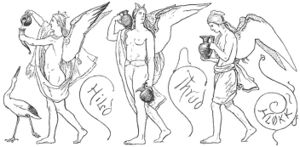

أشعار إدّا
ڤالهالا مذكورة بتفصيل مطوّل في أشعار إدّا في قصائد Grímnismál و Helgakviða Hundingsbana II, while Valhalla receives lesser direct references in stanza 33 of the Völuspá, where the god Baldr's death is referred to as the "woe of Valhalla",[5] and in stanzas 1 to 3 of Hyndluljóð, where the goddess فرييا states her intention of riding to Valhalla with Hyndla, in an effort to help Óttar, as well as in stanzas 6 through 7, where Valhalla is mentioned again during a dispute between the two.[6]
Grímnismál
In stanzas 8 to 10 of Grímnismál, the god Odin (in the guise of Grímnir) states that Valhalla is located in the realm of Glaðsheimr. Odin describes Valhalla as shining and golden, and that it "rises peacefully" when seen from afar. From Valhalla, every day Odin chooses from those who have died in combat. Valhalla has spear-shafts for rafters, a roof thatched with shields, coats of mail are strewn over its benches, a wolf hangs in front of its west doors, and an eagle hovers above it.[7]
From stanzas 22 to 24, more details are given by Odin about Valhalla: the holy doors of the ancient gate Valgrind stand before Valhalla, Valhalla has five hundred and forty doors that eight hundred men can exit from at once (from which the آينهريار will flow forth to engage the wolf Fenrir at Ragnarök). Within Valhalla exists Thor's hall Bilskirnir, and within it exist five hundred and forty rooms, and of all the halls within Valhalla, Odin states that he thinks his son's may be greatest.[8] In stanzas 25 through 26, Odin states that the goat Heiðrún and the hart Eikþyrnir stand on top of Valhalla and graze on the branches of the tree Læraðr. Heiðrún produces vats of mead that liquor cannot be compared to, and from Eikþyrnir's antlers drip liquid into the spring Hvergelmir from which flows forth all waters.[8]
Helgakviða Hundingsbana II
In stanza 38 of the poem Helgakviða Hundingsbana II, the hero Helgi Hundingsbane dies and goes to Valhalla. In stanza 38, Helgi's glory there is described:
So was Helgi beside the chieftains
like the bright-growing ash beside the thorn-bush
and the young stag, drenched in dew,
who surpasses all other animals
and whose horns glow against the sky itself.[9]
Prose follows after this stanza, stating that a burial-mound was made for Helgi, and that when Helgi arrived in Valhalla, he was asked by Odin to manage things with him. In stanza 39, Helgi, now in Valhalla, has his former enemy Hunding—also in Valhalla—do menial tasks; fetching foot-baths for all of the men there, kindling fire, tying dogs, keeping watch of horses, and feeding the pigs before he can get any sleep. In stanzas 40 to 42, Helgi has returned to Midgard from Valhalla with a host of men. An unnamed maid of Sigrún, Helgi's valkyrie wife, sees Helgi and his large host of men riding into the mound. The maid asks if she is experiencing a delusion, if Ragnarök has begun, or if Helgi and his men have been allowed to return.[9]
In the stanzas that follow, Helgi responds that none of these things have occurred, and so Sigrún's maid goes home to Sigrún. The maid tells Sigrún that the burial mound has opened up, and that Sigrún should go to Helgi there, as Helgi has asked her to come and tend his wounds, which have opened up and are bleeding. Sigrún goes into the mound, and finds that Helgi is drenched in gore, his hair is thick with frost. Filled with joy at the reunion, Sigrún kisses him before he can remove his coat of mail, and asks how she can heal him. Sigrún makes a bed there, and the two sleep together in the enclosed burial mound. Helgi awakens, stating that he must "ride along the blood-red roads, to set the pale horse to tread the path of the sky," and return before the rooster Salgófnir crows. Helgi and the host of men ride away, and Sigrún and her servant go back to their house. Sigrún has her maid wait for him by the mound the next night, but when she arrives at dawn, she finds that he has not returned. The prose narrative at the end of the poem relates that Sigrún dies of sadness, but that the two are thought to have been reborn as Helgi Haddingjaskati and the valkyrie Kára.[10]
إدّا النثرية
ڤالهالا مشار إليها في كتب إدّا النثرية Gylfaginning و Skáldskaparmál.
Gylfaginning
Valhalla is first mentioned in chapter 2 of the Prose Edda book Gylfaginning, where it is described partially in euhemerized form. In the chapter, King Gylfi sets out to Asgard in the guise of an old man going by the name of Gangleri to find the source of the power of the gods. The narrative states that the Æsir foresaw his arrival and had prepared grand illusions for him, so that when Gangerli enters the fortress, he sees a hall of such a height that he has trouble seeing over it, and notices that the roof of the hall is covered in golden shields, as if they were shingles. Snorri then quotes a stanza by the skald Þjóðólfr of Hvinir (c. 900). As he continues, Gangleri sees a man in the doorway of the hall juggling short swords, and keeping seven in the air at once. Among other things, the man says that the hall belongs to his king, and adds that he can take Gangleri to the king. Gangleri follows him, and the door closes behind him. All around him he sees many living areas, and throngs of people, some of which are playing games, some are drinking, and others are fighting with weapons. Gangleri sees three thrones, and three figures sitting upon them: High sitting on the lowest throne, Just-As-High sitting on the next highest throne, and Third sitting on the highest. The man guiding Gangleri tells him that High is the king of the hall.[11]
In chapter 20, Third states that Odin mans Valhalla with the Einherjar: the dead who fall in battle and become Odin's adopted sons.[12] In chapter 36, High states that valkyries serve drinks and see to the tables in Valhalla, and Grímnismál stanzas 40 to 41 are then quoted in reference to this. High continues that the valkyries are sent by Odin to every battle, where they choose who is to die, and determine victory.[13]
In chapter 38, Gangleri says: "You say that all men who have fallen in battle from the beginning of the world are now with Odin in Valhalla. With what does he feed them? I should think the crowd there is large." High responds that this is indeed true, that a huge amount are already in Valhalla, but yet this amount will seem to be too few when "the wolf comes." High describes that there are never too many to feed in Valhalla, for they feast from Sæhrímnir (here described as a boar), and that this beast is cooked every day and is again whole every night. Grímnismál stanza 18 is then recounted. Gangleri asks if Odin himself eats the same food as the Einherjar, and High responds that Odin needs nothing to eat—Odin only consumes wine—and he gives his food to his wolves Geri and Freki. Grímnismál stanza 19 is then recounted. High additionally states that at sunrise, Odin sends his ravens Huginn and Muninn from Valhalla to fly throughout the entire world, and they return in time for the first meal there.[14]
In chapter 39, Gangleri asks about the food and drinks the Einherjar consume, and asks if only water is available there. High replies that of course, Valhalla has food and drinks fit for kings and jarls, for the mead consumed in Valhalla is produced from the udders of the goat Heiðrún, who in turn feeds on the leaves of the "famous tree" Læraðr. The goat produces so much mead in a day that it fills a massive vat large enough for all of the Einherjar in Valhalla to satisfy their thirst from it. High further states that the stag Eikþyrnir stands atop Valhalla and chews on the branches of Læraðr. So much moisture drips from his horns that it falls down to the well Hvelgelmir, resulting in numerous rivers.[15]
In chapter 40, Gangleri muses that Valhalla must be quite crowded, to which High responds by stating that Valhalla is massive and remains roomy despite the large amount of inhabitants, and then quotes Grímnismál stanza 23. In chapter 41, Gangleri says that Odin seems to be quite a powerful lord, as he controls quite a big army, but he yet wonders how the Einherjar keep themselves busy when they are not drinking. High replies that daily, after they've dressed and put on their war gear, they go out to the courtyard and battle one another in one-on-one combat for sport. Then, when mealtime comes, they ride home to Valhalla and drink. High then quotes Vafþrúðnismál stanza 41. In chapter 42, High describes that "right at the beginning, when the gods were settling" they had established Asgard and then built Valhalla.[16] The death of the god Baldr is recounted in chapter 49, where the mistletoe that is used to kill Baldr is described as growing west of Valhalla.[17]
Skáldskaparmál
At the beginning of Skáldskaparmál, a partially euhemerized account is given of Ægir visiting the gods in Asgard and shimmering swords are brought out and used as their sole source of light as they drink. There, numerous gods feast, they have plenty of strong mead, and the hall has wall-panels covered with attractive shields.[18] This location is confirmed as Valhalla in chapter 33.[19]
In chapter 2, a quote from the anonymous 10th century poem Eiríksmál is provided (see the Fagrskinna section below for more detail and another translation from another source):
What sort of dream is that, Odin? I dreamed I rose up before dawn to clear up Val-hall for slain people. I aroused the Einheriar, bade them get up to strew the benches, clean the beer-cups, the valkyries to serve wine for the arrival of a prince.[20]
In chapter 17 of Skáldskaparmál, the jötunn Hrungnir is in a rage and, while attempting to catch up and attack Odin on his steed Sleipnir, ends up at the doors to Valhalla. There, the Æsir invite him in for a drink. Hrungnir goes in, demands a drink, and becomes drunk and belligerent, stating that he will remove Valhalla and take it to the land of the jötunn, Jötunheimr, among various other things. Eventually, the gods tire of his boasting and invoke Thor, who arrives. Hrungnir states that he is under the Aesir's protection as a guest and therefore he can't be harmed while in Valhalla. After an exchange of words, Hrungnir challenges Thor to a duel at the location of Griotunagardar, resulting in Hrungnir's death.[21]
In chapter 34, the tree Glasir is stated as located in front of the doors of Valhalla. The tree is described as having foliage of red gold and being the most beautiful tree among both gods and men. A quote from a work by the 9th century skald Bragi Boddason is presented that confirms the description.[22]
هايمسكرينگلا
Valhalla is mentioned in euhemerized form and as an element of remaining Norse pagan belief in هايمسكرينگلا. In chapter 8 of Ynglinga saga, the "historical" Odin is described as ordaining burial laws over his country. These laws include that all the dead are to be burned on a pyre on a burial mound with their possessions, and their ashes are to be brought out to sea or buried in the earth. The dead would then arrive in Valhalla with everything that one had on their pyre, and whatever one had hidden in the ground.[23] Valhalla is additionally referenced in the phrase "visiting Odin" in a work by the 10th century skald Þjóðólfr of Hvinir describing that, upon his death, King Vanlandi went to Valhalla.[24]
In chapter 32 of Hákonar saga Góða, Haakon I of Norway is given a pagan burial, which is described as sending him on his way to Valhalla. Verses from Hákonarmál are then quoted in support, themselves containing references to Valhalla.[25]
Fagrskinna
In chapter 8 of Fagrskinna, a prose narrative states that after the death of her husband Eric Bloodaxe, Gunnhild Mother of Kings had a poem composed about him. The composition is by an anonymous author from the 10th century and is referred to as Eiríksmál, and describes Eric Bloodaxe and five other kings arriving in Valhalla after their death. The poem begins with comments by Odin (as Old Norse Óðinn):
"What kind of a dream is it," said Óðinn,
in which just before daybreak,
I thought I cleared Valhǫll,
for coming of slain men?
I waked the Einherjar,
bade valkyries rise up,
to strew the bench,
and scour the beakers,
wine to carry,
as for a king's coming,
here to me I expect
heroes' coming from the world,
certain great ones,
so glad is my heart.[26]
The god Bragi asks where a thundering sound is coming from, and says that the benches of Valhalla are creaking—as if the god Baldr had returned to Valhalla—and that it sounds like the movement of a thousand. Odin responds that Bragi knows well that the sounds are for Eric Bloodaxe, who will soon arrive in Valhalla. Odin tells the heroes Sigmund and Sinfjötli to rise to greet Eric and invite him into the hall, if it is indeed he.[27]
Sigmund asks Odin why he would expect Eric more than any other king, to which Odin responds that Eric has reddened his gore-drenched sword with many other lands. Eric arrives, and Sigmund greets him, tells him that he is welcome to come into the hall, and asks him what other lords he has brought with him to Valhalla. Eric says that with him are five kings, that he will tell them the name of them all, and that he, himself, is the sixth.[27]
Gylfe Stood Boldly Before Odin (1908) by George Hand Wright
A depiction of valkyries encountering the god Heimdallr as they carry a dead man to Valhalla (1906) by Lorenz Frølich
التأثير المعاصر
The concept of Valhalla continues to have influence in modern popular culture. Examples include the معبد ڤالهالا built by Leo von Klenze for Ludwig I of Bavaria between 1830–1847 near Regensburg, Germany, and the Tresco Abbey Gardens Valhalla museum built by August Smith around 1830 to house ship figureheads from shipwrecks that occurred at the Isles of Scilly, England, where the museum is located.[28]
References to Valhalla appear in literature, art, and other forms of media. Examples include K. Ehrenberg's charcoal illustration Gastmahl in Walhalla (mit einziehenden Einheriern) (1880), Richard Wagner's depiction of Valhalla in his opera cycle Der Ring des Nibelungen (1848–1874), the Munich, Germany-based Germanic Neopagan magazine Walhalla (1905–1913), and the comic series Valhalla (1978–2009) by Peter Madsen, and its subsequent animated film of the same name (1986).[28] Valhalla also gives its name to a thrill ride at Blackpool Pleasure Beach, UK.
In the 2015 film Mad Max: Fury Road, the cult of the War Boys believe that a heroic death in the service of dictator Immortan Joe will take them to Valhalla.
A video game with the title Assassin's Creed Valhalla would be released in 2020.[29]
معرض صور
The Walhalla temple فوق الدانوب بالقرب من رگنزبورگ، ألمانيا
انظر أيضاً
ملاحظات
- ^ "Valhalla". Random House Webster's Unabridged Dictionary.
- ^ Orchard (1997:171–172).
- ^ أ ب For analysis and discussion, see Orel (2003:256, 443) and Watkins (2000:38).
- ^ Simek (2007:347).
- ^ Larrington (1999:8).
- ^ Larrington (1999:253–254).
- ^ Larrington (1999:53).
- ^ أ ب Larrington (1995:55).
- ^ أ ب Larrington (1999:139).
- ^ Larrington (1999:139–141).
- ^ Byock (2005:10–11).
- ^ Byock (2005:31).
- ^ Byock (2005:44–45).
- ^ Byock (2005:46–47).
- ^ Byock (2005:48).
- ^ Byock (2005:49-50).
- ^ Byock (2005:66).
- ^ Faulkes (1995:59).
- ^ Faulkes (1995:95).
- ^ Faulkes (1995:69).
- ^ Faulkes (1995:77–78).
- ^ Faulkes (1995:96).
- ^ Hollander (2007:12).
- ^ Hollander (2007:17).
- ^ Hollander (2007:125).
- ^ Finlay (2004:58).
- ^ أ ب Finlay (2004:59).
- ^ أ ب Simek (2007:348).
- ^ "Assassin's Creed Valhalla is Assassin's Creed with vikings". The Verge. 29 April 2020.
الهامش
- Byock, Jesse (Trans.) (2006). The Prose Edda. Penguin Classics. ISBN 0-14-044755-5
- Faulkes, Anthony (Trans.) (1995). Edda. Everyman. ISBN 0-460-87616-3
- Finlay, Alison (2004). Fagrskinna, a Catalogue of the Kings of Norway: A Translation with Introduction and Notes. Brill Publishers. ISBN 90-04-13172-8
- Hollander, M. Lee (Trans.) (2007). Heimskringla: History of the Kings of Norway. University of Texas Press. ISBN 978-0-292-73061-8
- Larrington, Carolyne (Trans.) (1999). The Poetic Edda. Oxford World's Classics. ISBN 0-19-283946-2
- Orchard, Andy (1997). Dictionary of Norse Myth and Legend. Cassell. ISBN 0-304-34520-2
- Orel, Vladimir (2003). A Handbook of Germanic Etymology. Brill. ISBN 9004128751
- Simek, Rudolf (2007) translated by Angela Hall. Dictionary of Northern Mythology. D.S. Brewer ISBN 0-85991-513-1
- Watkins, Calvert (2000). The American Heritage Dictionary of Indo-European Roots. Houghton Mifflin Company. ISBN 0-395-98610-9
- Welch, Chris (2005). Led Zeppelin: Dazed and Confused: The Stories Behind Every Song. Thunder's Mouth Press. ISBN 978-1-56025-818-6
